Hindu Background
Historical Background: Hindu-2
 Rigveda in Classical Sanskrit. (Eames Collection, Chicago, no. 1956; 2. Newberry Library, Chicago, 19c.)
Rigveda in Classical Sanskrit. (Eames Collection, Chicago, no. 1956; 2. Newberry Library, Chicago, 19c.)
Hindu is not the name of a religion. It derives from the word, Sindhu, which was the main river in the Sindhu/Indus Valley Civilization (2600-1900 BCE) and was probably corrupted by the Arabs, with whom the people of the Valley had trade links. In fact, the culture of this region was called ‘Vedic’ (based on its scriptural texts), till about the 8th century, CE, when the first Muslim invader called the people of the region (all people) ‘Hindu’. So, Hindu is a way of life; it refers to a civilization, and this culture is just as alive today as it was thousands of years ago.
Hindu mythology is, perhaps, the only living mythology in the world today.

The Great Bath at Mohenjo-Daro, one of the archeological sites of the Indus Valley (Wikipedia.org)
One of the reasons why the Hindu pantheon and the Hindu myths survived (unlike the Greek ) is because of the fluid and fixed nature of the texts. Hindu mythology derives from two kinds of Holy Texts. The Shruti (revealed) texts and the Smriti (Tradition) texts. The four Vedas were the first Shruti texts ( Rig Veda, Sama Veda, Atharva Veda , and Yajur Veda) These were not only fixed but were also closed texts. They were the true mythos (divine utterance with no authorship). Only a select few were allowed to utter their verses and that, too, in classical Sanskrit (an ancient form of Sanskrit), a language considered to be the language of the gods; thus no ordinary man or woman was allowed to use it, because the magic was considered to be in the WORD, and the magical formula was in its pure utterance. Naturally, then, the texts were totally oral and were not allowed to be written to prevent corruption. Veda means knowledge (from the root: vid=know)
Western scholars believe that the first Veda, the Rig was written in the about 2000 BCE. However, considering the assumed sanctity of its Word, it was probably in oral tradition about a thousand some years prior that. (The Indian scholars date it to about 5000 BCE)
Each Veda has two parts: the Samhita, which is the collection of hymns, and the Brahmanas, which contain the commentaries and handbooks of rules & regulations for the sacrifices ordained in the hymns. The Brahmanas are further divided into two parts: Aryankas, which means ‘of the forest,’ and detail meditative yogic practices; and the Upanishads, which are also known as Vedanta–the end of Vedas. These are metaphysical writings about the soul (atma) and Eternal Brahman–the cosmic Soul. The Upanishad literally means ‘sit-down-near’, but its connotations could be sitting down at someone’s feet to learn secret knowledge. Some even see it as setting down of ignorance. The Upanishads eventually came to be known as redemptive knowledge and gained spiritual authority; thus they began to be seen as separate from Brahmanas. There are 108 extant Upanishads and these clearly reflect the very first traces of not just monotheism but also monism.
The other set of literary texts, which, perhaps, are more significant in terms of mythology are all post-Vedic texts, such as the Smritis or ‘remembered’ literature. These include itihas epics– the Mahabharata and Ramayana. Itihas means ‘thus it was’ and later came to mean the discipline of history. These were probably written between 500-200 BCE, but many Indian scholars believe that they were in existence long before that in oral tradition. For example, Aryabhatta, the 5th century CE Indian mathematician and astronomer dated the great epic battle of the Mahabharata to 3102 BCE.
In addition, there are about 36 Puranas. Purana means ancient. These are religious and philosophical narratives about cosmology, genealogies of gods, demigods, heroes, sages, etc. They also contain histories of the universe’s creation and destruction. Eighteen of these are considered Maha or Great Puranas and 18 are Up or lesser in value. The Maha Puranas are each devoted to a specific deity, making him/her supreme among the other gods. This validates the concept of henotheism that Max Mueller formulated, which means ‘worshiping a single god while accepting that other gods also exist.’
The Puranas were probably written between the 4th to the 12 centuries CE. However, the myths contained in them were probably prevalent as folk narratives centuries before then.
By the time of the epic and Puranic period, myths belonged to the common people. These texts were completely fluid in nature, incorporating into their corpus, polemic of contending philosophical systems, such as Buddhism and Jainism, aboriginal beliefs, and even ‘foreign’ thought, such as that of Greek philosophers. Thus, Hinduism was open to anything.
This culture of the Vedas was probably brought into India (Indus Valley) by the Aryans, who came from Central Asia, (most likely), as migrant pastoralists and settled in the Indus Valley and then moved to the Gangetic Plain. It is believed that all the ‘Hindu’ texts were created in the latter period.
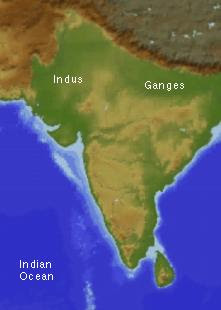
Map of India; Indus and Ganga (Ganges) rivers
The Aryans mingled with the original inhabitants, who were basically agriculturists and traders and had a pantheon of nature gods of their own. Instead of destroying the aboriginal beliefs and myths, the Aryans incorporated them into their own Cosmology; this tradition of adoption continues even till today.
Over the centuries, numerous versions of the epics developed, each with a different rendering, incorporating sociological and cultural changes, but each revered as necessary and ‘true.’ Whatever new prophet came to be, Hinduism adopted him as its own. For example, Buddhism was a heterodox religion that grew out of and in opposition to Vedic ideas, but after a period of contention, post Vedic Hindu thought incorporated Buddhist thought into its traditions. Similarly, when the Christians came to India, Hinduism included the Christians myths in its tradition. It is said that in first century CE, Saint Thomas came to India, and Jesus Christ came to be recognized as an incarnation of Vishnu, one of the chief Hindu gods, who is supposed to reincarnate ten times. Thus, from a polytheistic system, Hinduism began to slowly adopt traditions of monotheism, where people began to believe that a completely personal relationship between God and the devotee was possible. This idea of personal devotion or bhakti, as it was commonly called, became the dynamic force of later Hinduism.
The change in the theological attitudes and the incorporation and relevance of all spiritual thought is perhaps best expressed in the philosophy of The Bhagavad Gita, which is a part of The Mahabharata. (You will read a section of the Gita in the second unit of the course.)
. The most significant element of Hindu mythology is that nothing is ever discarded, nothing dies, and “nothing is ever ‘created’ ex nihilo; rather, things are constantly rearranged, each put in its proper place” (Doniger), time and again. The universe is a system of polarities: male/female, good/evil, god/demon, hot/cold, which are also constantly re-arranged, because all possibilities exist simultaneously. However, ultimately, everything is Maya or illusion, and in the final reckoning, there is only the One (not God), but simply Oneness.
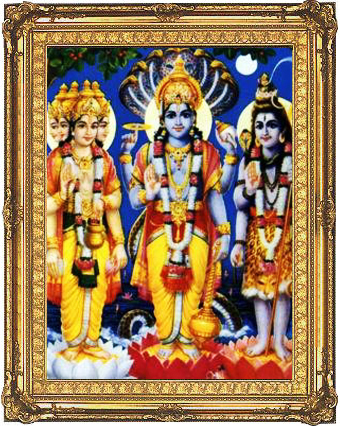
The Hindu pantheon consists of numerous gods, so numerous, in fact, that it would be impossible to list all of them and their attributes. There are 33, 333 or 3,333, or 333 chief gods (depending on different categorization–Vedic, epic, Puranic, etc.) and many lesser ones. The following are the three main gods of post Vedic epic/Puranic Hinduism (Trimurti). They have roots in early Vedic cosmology, but in later epics and Puranas, their myths gained more dimentionality.
NOTE: Although each of these three gods have their own chief function (creation, preservation, destruction), the two main gods, Vishnu and Shiva, while fulfilling their key function (Vishnu: preservation and Shiva: destruction), are considered ‘complete’, because they embody the triple functions of a Supreme Divine–namely creation, preservation, and destruction. What this means is that Vishnu and Shiva are capable of all three functions.
Brahma (see image on far right) the creator god, (see also creation myth in the module for “Man & Divine”.)
He has four heads and four arms, which are symbols of his omni-presence and omni-potency. Brahma is the only god who does not hold any weapons, because his function is simply to create. Like most sky gods, or creator gods, once creation was complete, Brahma lost his significance.
Brahma’s wife is Saraswati, the goddess of wisdom and the arts. She is worshiped by students and educators alike, and her images can be seen in most educational institutions in India.
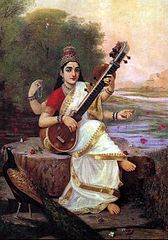
Saraswati
Vishnu
Vishnu is one of the most important gods of the Hindu pantheon. (He is the divine in the center of the Trinity) He is the executor, savior, and protector of mankind. He incarnates to alleviate the earth of evil forces. In some traditions, he is also equated as the Supreme, the One, the Eternal Brahman (Not the same as Brahma, the creator god). However, despite his variousness, or the existence of other gods, all Hindus believe in the ultimate reality of One.
In his four hands Vishnu holds a lotus, which symbolizes his creation (see creation myth); a disc, which is his weapon of choice. This symbolizes the cyclic nature of time and Great Time’s annihilation of the world; a conch shell, from which the elemental sound of Aum, (Om) the sound of creation, is produced; and a mace, which symbolizes his power of destruction.
The texts describe him to have ten reincarnations (avatars), nine of which have already been and the tenth will be Kalki. In his third incarnation of a boar, he rescued the earth from the ocean. (You will read this myth in the second Unit)
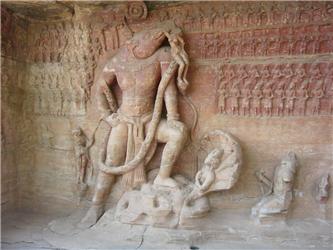
Vishnu’s boar avatar
His two most important incarnations are Rama (7th avatar and protagonist of the world’s first epic poem, Ramayana).
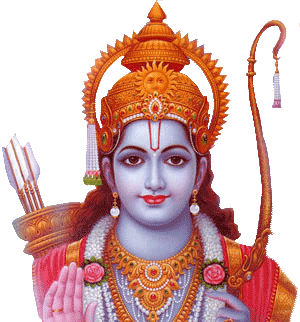 Rama
Rama
and Krishna (the 8th incarnation), an important, catalytic character in The Mahabharata. Once monotheism became prevalent, it was Vishnu, who became the chief deity, sometimes worshiped as Rama and sometimes as Krishna.
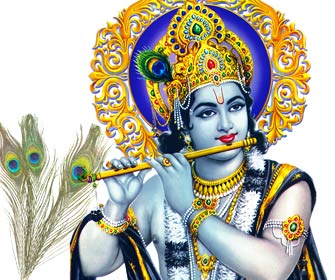
Krishna
In his Krishna avatar, Vishnu recited the Bhagavad Gita during the war of the Mahabharata. The Gita is included in the sixth chapter of the Mahabharata and is one of the most important Hindu scriptures. It teaches humans the path to a live in a rightful way; it teaches metaphysical truths about the soul; and it teaches the yoga of devotion to a personal god; thus facilitating transcendence.
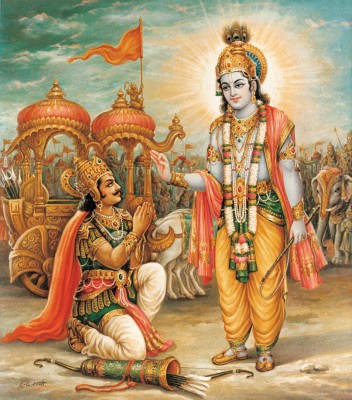
Krishna reciting the Bhagavad Gita on the battlefield of Kurukshetra
Vishnu has two wives, or rather two aspects of the same consort: Lakshmi, goddess of fortune and wealth, and Prithvi, the Earth goddess, who is rarely ever shown in images, since she represents the earth.
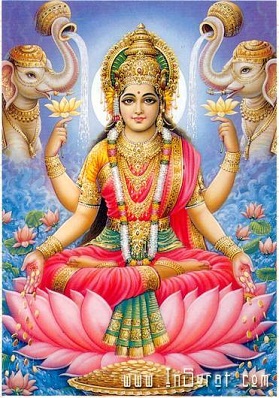
Laxmi
Shiva (the third god in the Trinity)
is the destroyer of this illusory world. At doomsday, he will annihilate the world so that Brahma can create a new one. That is why he is sometimes depicted as dancing his dance of Death ( Tandava) which represents cyclic nature of life, existence, and time. He is equated to the dark forces of death and destruction, but he is also considered the sustainer of life; therefore, his destruction does not have negative connotations.
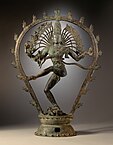
Shiva as the Lord of Dance. Chola Bronze, 3rd cent. BCE
Shiva is normally shown as having a normal skin tone except for his throat, which is blue, because he drank the venom, which was threatening to poison the world’s oceans at the time of creation. Bound in his locks is the holy and life giving waters of the river Ganges, which flow out in a stream (You will read this myth in Unit 2). He has three eyes, the two normal eyes represent the sun and moon, and the third, on his forehead, is Fire. This is also considered the eye of knowledge or one that burns to ashes all ignorance.
Shiva wields the trident, which represents the forces that move the world–will, action, and intellect. Around his body, he wears serpents, which represent the invisible cosmic energy in our body. Shiva is also the creator and is usually represented by the image of a lingam (male sexual organ) standing erect in a yoni (vulva), symbolizing that the universe is a balance of male and female energies and that without the balance of the two, creation is not possible. This form, called the shivalingam is how he is most commonly worshiped. He rides a bull called Nandi who is considered an embodiment of sexual desire, but by Shiva riding it, he brings sexual desire under control. Nandi is also a form of Dharma (righteousness and duty), thus denoting that not only is sexual desire rightful but by Shiva riding it, it also means that sexual desire has to be used in a rightful (dharma) manner.

Shivalingam
The female energy complementing Shiva is called Shakti, and all his four wives, or rather, all four aspects of his consort, are referred to with the common name of Shakti. The four forms are Parvati, Gauri, Durga, Kali. Shiva and Shakti together represent the totality and absoluteness of creation–latent male energy and creative female energy.

Ardhanarishvara–half male (Shiva), half female (Shakti)
Parvati is the goddess of love and romance. She is young, beautiful and full of life and her eternal amorous play with Shiva represents the perfect male female union.
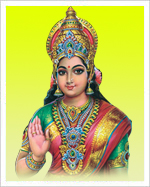
Parvati
Gauri represents austerity and purity. She upholds motherhood with its attributes of caring and nurturing.
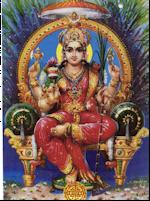
Gauri
Durga represents justice and the power of womanhood. She is a warrior goddess, She rides a tiger or lion) and carries the weapons of battle. NOTE: Durga is not a counterpart of the male divine, but is considered a complete Supreme Divine who embodies the triple function of creation, preservation, destruction. She is also considered the Great Mother (Ma). (You will read her myth in Unit 2)
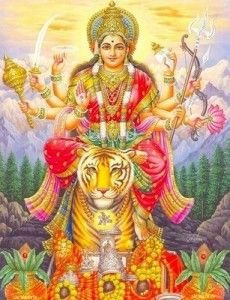
Durga
The goddess, Kali is wild and terrible. (NOTE: these connotations are not negative) . She is usually depicted naked, wearing a necklace of human heads and a skirt of human arms. Blood drips from her sword. She represents the dark powers that can be evoked in feminine energy. However, she is also referred to as ‘mother.’ (See also Kali myth in “Man & Divine”.)
NOTE: Kali, too, is not a counterpart of the male divines but is also considered a complete Supreme Divine who embodies the triple function of creation, preservation, destruction.
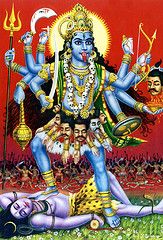 Kali
Kali
Ganesha is one of Shiva’s sons. He has the head of an elephant and an overweight body of a youth. He has four hands which hold a manuscript, a sweetmeat, an axe and a noose. Ironically, he rides a mouse. He is the god of good beginnings and perhaps the most ritualized god in Hindu society. His body is supposed to represent the sacred elemental syllable, Om, and all his other attributes represent benevolence, wisdom and humility.
He is considered the god of good beginnings, wisdom, and the god who removes all obstacles (as represented by the objects he holds).
 Ganesha
Ganesha
Some of the other important gods
With the transformation of the system, and the evolving of old gods to new gods, these following chief gods lost their importance and are not worshiped today; however, their myths are still alive, and they are still ritualized in prayer and religious ceremonies.
Indra, the king of gods, ruler of heaven. He is a crafty god, and, like Zeus, does everything he can to maintain his power. Also like Zeus, he is the lord of the storm clouds, and he wields the thunderbolt.
Agni, fire and also the god of Fire. He is considered the chief link between mortals and immortals, because he carries the sacrifice to the gods. He also bears witness to all ritual oaths, such as marriage.
Surya, the sun god, is brilliant and benevolent for the most part.
Vayu the wind god is mighty and powerful
The Aswin twins are gods of healing. It is believed that they gave to the humans the secrets of medicine and are considered the fathers of Ayurveda (an Eastern system of healing through balancing elements in the human body. Yoga is one aspect of it.)
The Asuras
(loosely translated: demons) They are an important part of Hindu mythology. However, they cannot be considered ‘evil’. They are simply dark forces, just as the gods are forces of light. Since, in Hindu philosophy, the world is a balance of polarities, these demons are just as accepted and as necessary as the gods. In fact, the demons have their own traditions of dharma (righteousness) (see below), and a demon practicing his own dharma to the best of his ability is just as evolved as a god or mortal, and sometimes even more so.
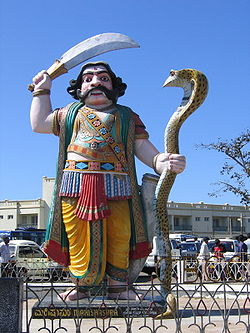
Asura Mahisa

